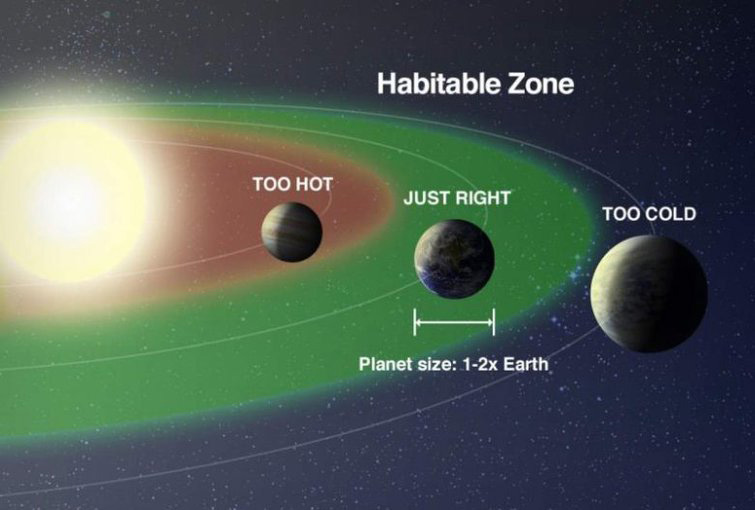Expanded from question two of the big three heliophysicist investigative questions: How do the Earth, the solar system, and heliosphere respond to changes on the Sun? Learn more ›
The habitable zone is the area around a star where it is not too hot and not too cold for liquid water to exist on the surface of surrounding planets.Imagine if Earth was where Pluto is. The Sun would be barely visible (about the size of a pea) and Earth's ocean and much of its atmosphere would freeze. On the other hand, if Earth took Mercury’s place, it would be too close to the Sun and its water would form a steam atmosphere, quickly boiling off. The distance Earth orbits the Sun is just right for water to remain a liquid. This distance from the Sun is called the habitable zone, or the Goldilocks zone. Rocky exoplanets found in the habitable zones of their stars, are more likely targets for detecting liquid water on their surfaces. Why is liquid water so important? Life on Earth started in water, and water is a necessary ingredient for life (as we know it).

Best Practice! Using Guiding Questions to Drive Inquiry
Each big idea has student-friendly questions written at different levels that you can use to guide inquiry-based investigations at the appropriate level. Explore this big idea at each level below, with featured resources you can engage learners with.
Introductory Learner
Guiding Question: How can life exist on Earth?
Standards: LS1, LS2
Heliophysics Narrative:
- Earth is the only place in the universe that we know of where life exists. Life exists on Earth because of many important factors: we have the perfect-sized star to live next to, we are the perfect distance from the Sun , it's not too hot or too cold, and we have liquid water. It is no surprise we call the place where Earth is located the "Goldilocks Zone" or the "Habitable Zone." Earth also has an atmosphere and a magnetosphere, which form protective layers around Earth.
- At this level students know that plants need sunlight and water to grow (2-LS2-1) and begin to learn about the energy flow from the Sun to plants, and then to other organisms in the ecosystem (K-LS1-1)(5-LS1-1). Students at this level are also familiar with the planets in the solar system and that most places are far too cold or too hot to live! As they progress, students will also be able to articulate which objects in the solar system have atmospheres and magnetospheres, and which do not. For example, students know that they can't breathe on the Moon or Mars.
- Connect to the Sun by emphasizing the uniqueness of Earth's position in the solar system, within the Goldilocks Zone. Not only are we unique in our solar system, but unique in the universe. NASA looks for evidence of life on planets around other stars, and so far, we have not found another planet like Earth. Both Venus and Mars are in the Goldilocks Zone, but Mars doesn't have a very robust atmosphere and it is too cold for most organisms. Venus has a toxic atmosphere and has extremely hot temperatures. The Earth is very, very special.
- Extend student exploration by investigating extremophiles on Earth that can live in extreme environments. For example, bacteria that can survive in boiling acid. Scientists think that if life exists elsewhere in the universe, it may be an extremophile. But even the most extreme organisms on Earth rely on water to live, even if it is a very small amount. So scientists look for the existence of water on other planets, with the hope that someday we will discover some sort of life there.
- Support younger students by emphasizing the need for both sunlight and water for plants to grow.
- Challenge students at the next level by exploring the flow of solar energy into plants, which are then consumed in other parts of the ecosystem.
Featured Resource: What is the Habitable Zone? ›
Intermediate Learner
Guiding Question: How does energy from the Sun support life on Earth?
Standards: LS1, LS2, PS4
Heliophysics Narrative:
- Energy from the Sun provides heat, light, and food for organisms on Earth. Food energy cycles through the ecosystem through producers (plants, algae, phytoplankton and other microorganisms that use photosynthesis to convert energy from sunlight to sugar) to consumers (organisms that eat plants and other organisms), and then to decomposers (organisms that recycle nutrients through the ecosystem). Without producers, most life could not exist on Earth.
- At this level, students investigate how matter and energy are transferred between producers, consumers, and decomposers throughout an ecosystem (MS-LS1-6) (MS-LS2-3). They also explore how light is absorbed, reflected, or transmitted through an object, depending on the object's materials and the frequency of the light (MS-PS4-2).
- Connect to the Sun by discussing why plants are green. The Sun emits all light across the EM spectrum, but visible light is the only part of the spectrum that humans can see. All photosynthetic organisms contain a special light absorbing molecule (a pigment) called chlorophyll b, which helps photosynthesis by absorbing light. Chlorophyll b reflects green (visible) light and absorbs almost all other wavelengths of visible light, which is why plants are green.
- Extend student exploration through examination of how energy and matter get recycled through ecosystems over and over again, specifically on how without decomposers (e.g. bacteria, fungi, earthworms, etc.) the ecosystem could not function.
- Support beginner students with food web models (LS1, LS2).
- Challenge students at the next level to quantify their observations of cycling of energy and matter through the food chain with the law of conservation of energy.
Featured Resource: NASA Exoplanets Interactive Webpage ›
Advanced Learner
Guiding Question: Does life exist on other planets?
Standards: ESS2, LS1
Heliophysics Narrative:
- While scientists have explored planets and moons in our solar system for signs of life, and have confirmed over 5000 exoplanets (planets outside of the solar system), no life has been discovered outside of the Earth environment. When scientists look for extraterrestrial life, they look for evidence of the basic elements required for biological life as we know it on Earth. These elements include oxygen, hydrogen, nitrogen, and phosphorus and chemical energy molecules (glucose and ATP). Because the life we know of here on Earth requires water to survive, scientists also look for planets with the potential to have liquid water. The life we expect to encounter may resemble the earliest forms of life on Earth, bacteria, for example. This is because, of all organisms, bacteria has existed on Earth since nearly its formation. Bacteria is the most common and ancient organism on Earth, and scientists hypothesize that to be the case elsewhere.
- At this level, students continue to investigate Earth's systems and how they interact with one another (HS-ESS2-2,7) and recognize that water plays a critical role in all of Earth's systems (HS-ESS2-5). Students further explore how life evolved on Earth by studying the chemical energy molecules involved in photosynthesis (HS-LS1-5, 7) and investigating the molecules needed to construct DNA, for example, proteins (HS-LS1-6).
- Connect to the Sun by emphasizing that life on Earth has co-evolved with Earth's systems and that the Sun plays a critical role in the evolution of Earth and life on Earth. Even before scientists look at planets that could potentially host life, they first look at the host star. The Sun is a medium-sized star, which allows it to live a longer lifespan (~15 billion years), giving time for life on Earth to evolve. Larger mass stars live shorter lives (sometimes only millions of years), which is not adequate time for life to take hold on a planet, and produce huge amounts of harmful radiation, which life cannot tolerate.
- Extend student exploration by having them investigate other planetary systems and compare them to the solar system.
- Support beginner students with detailed food webs to show how energy and matter move through an ecosystem (MS-LS2,3).
- Challenge students at the next level to further explore how Earth and life co-evolved, for example the relationship of photosynthesis and cellular respiration (the products of one process are the reactants of the other).
Featured Resource: Astrobiology Graphic Novel Series ›
What level are my learners?
Introductory: A younger learner (K-5), or a learner new to the subject matter.
Intermediate: A middle-aged learner (6-8), or a learner that has some familiarity with the subject matter.
Advanced: An older learner (9-12+), or a learner that has a lot of experience with the subject matter.
Note: Next Generation Science Standards (K-12) are mapped to the resources accordingly.
What is a NGSS Heliophysics Narrative?
NGSS Heliophysics Narratives support educators with the incorporation of heliophysics concepts and resources into their existing curricula. The narratives consist of relevant heliophysics background information, applicable NGSS performance expectations, and guiding questions to spark inquiry-based learning at the appropriate level.
Narrative Structure:
- Short answer to the question, for teacher background knowledge
- An analysis of NGSS Performance Expectations (PE) to determine learning constraints at each level
- Heliophysics topics that connect to the NGSS PE and can be infused into teaching systems science
- More heliophysics to explore
- How to support beginner learners
- How to challenge learners at the next level





